|
 |
 |
Hamam Heaven
- Tuesday, December 30, 2003 |
 |
 |
 |

Another tradition we thoroughly enjoyed was visiting a traditional Turkish bath –Hamam. The day before leaving Turkey we felt well enough to make a visit to one of the local Hamams. There were about six to choose from, and we picked the oldest one in Istanbul which was reputed to be very sanitary. This Hamam segregated the men and women unlike many which are communal. We each had a similar experience but believe that D got the better end of the deal due to his intense massage.
On the women’s side, I hit the lockers (similar to any gym) and was given a towel, pair of flip flops, and a chip to hand the masseuse. With nothing but a towel wrapped around me, I entered an ancient domed room full of steam with a 30 ft diameter round marble slab heated from below filled wall to wall with naked bodies. I guess the sign saying “No nudity. A towel must be worn at all times” was merely a formality. A woman who worked there grunted at me, pointed to a tiny spot free in the middle of the slab, then helped me climb over several bodies to get there. At first the nudity was a bit of a shocker, but it immediately wore off as I relaxed on the stone along with the other immodest, dozing women. About 15 minutes later, a ½ naked lady grabbed my foot and started pulling me toward the edge for my massage. Other women were placed closely along the outside border and were also getting massaged. This was no ordinary massage. First they threw a few buckets of hot water on me, then came the bucket of foam that caught me unaware and was thrown on me haphazardly. I was scrubbed front and back with a loofah and then received a pretty crappy massage for ~ 20 minutes. After the massage, my masseur rinsed me off at one of the ancient marble faucets and proceeded to wash my hair. I was then sent back to the marble slab to go relax. Overall it was a great experience. I wish me had these places at home. I was told later by a local that the Hamam we visited was not well-known for the quality of their women masseurs. Apparently, we were directed to a very touristy Hamam. Ordinary ones have better trained staff and include hour massages for the same $10!! I’m not complaining, as I left the place feeling like a noodle…
The sequence of events was similar on the men’s side, except that everyone kept their towel on during the entire process. Dave’s massage and scrubbing was a modest affair with all scrubbing and massaging taking place around the towel unlike M’s experience. D felt like a pot being scrubbed with a Brillo pad during his loofah session. Not a speck of dirt left. Though D’s masseur didn’t have much finesse, he left standing a little taller after his back cracked like “snap, crackle, and pop!” According to D, the massage felt like one of the wrestling matches he used to have with his younger brother Jon. Visiting the Hamam was an interesting experience, even if ours was a bit touristy.
|
 |
 |
 |
 |
 |
 |
 |
Istanbul - Second Time around
- Sunday, December 28, 2003 |
 |
 |
 |

Istanbul is the only city in the world built on two continents. Its history is a very long one. In 395 AD (when Istanbul was named Constantinopel) the city was made capital of the Eastern Roman Empire.
Domes and minarets fill the skyline. The city is a continual bustle of crowds, the rumbling of vehicles on cobblestone streets, and the cries of street vendors. After our time in Cappadocia, we took the dreaded 12-hour bus ride back to Istanbul and actually caught some shut eye. Unfortunately, we both seem to have picked up a nasty cold from our fellow bus mates. Within two days our cold had turned into a nasty bacteria infection requiring a doctors visit complete with Penicillin. Most of the week was spent recovering, but we did manage to visit both the Ayasofia and Blue Mosque. These impressive sights are across the street from each other and make for a striking skyline with their minarets reaching toward the sky.
The Ayasofia (or Hagia Sophia) church (a UNESCO World Heritage site) changed the course of Western architecture and was the greatest church in Christendom until St Peter's Basilica was built in Rome a thousand years later. The basilica was covered with the magnificient dome 182 ft high and 105 ft in diameter, with 40 frame timbers and 107 pillars. Even though it was in a state of restoration it was one of the most spectacular buildings we have ever seen.
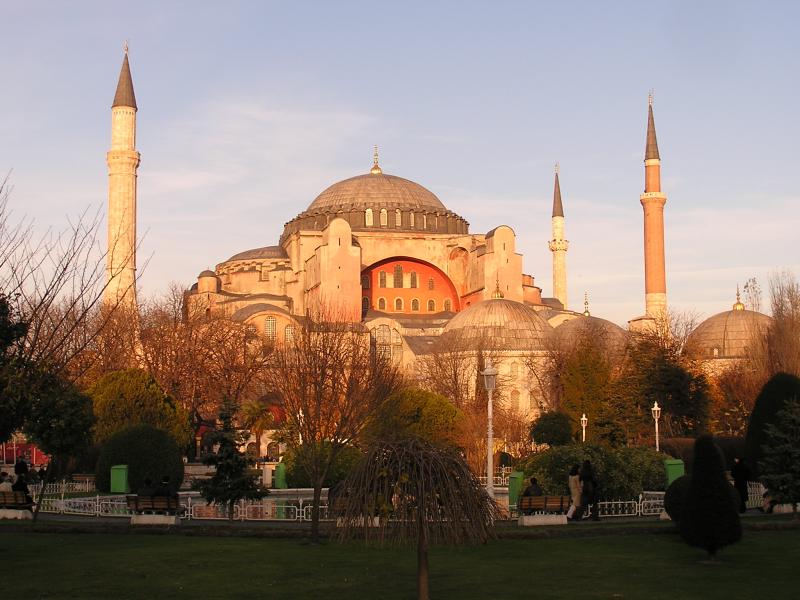
In 1453, with the conquest of Istanbul, Sultan Mehmed the Conqueror converted the church into a mosque. Hagia Sophia Museum, the legacy of both Christian and Muslim culture, was opened for visits according to the order of Ataturk and decision of the Turkish Assembly of Ministers on the 1st of February, 1935.
The Blue Mosque or Sultanahmet Mosque was built by Sultan Ahmet I during 1609-1616 in the square carrying his name, on the site of the Great Palace of Byzantium. It is the only mosque in Turkey with six minarets. Two hundred and sixty windows surround this huge mosque measuring 210 ft L x 236 ft W. The central dome is 141 ft H by 110 ft in diameter . Due to its beautiful blue, green and white tilings it has been named the "Blue Mosque" by Europeans.
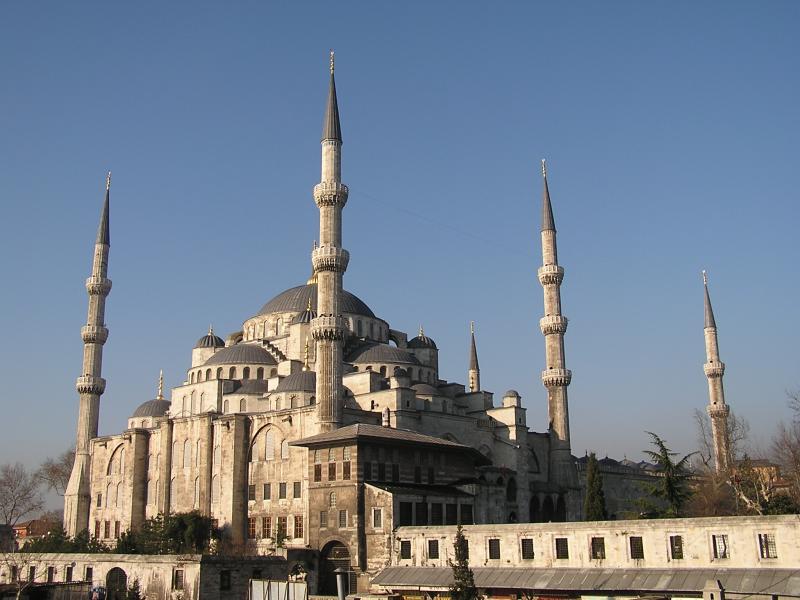
A carpet tout at the Blue Mosque struck up a conversation with us and invited us back his shop for some tea and a balcony view of the Blue Mosque. "Come have some tea", is code for ome to my shop and buy a carpet. These guys wont take no for an answer, even if you tell them you already bought a carpet and are not going to buy another. They counter with "it's just tea... and Turkish hospitality!". So we followed the tout to get a good pic of the Blue Mosque then had to worm our way out of the shop without buying anything. Of course our new friend wouldn't let us get away without visiting his cousin's leather shop. M was wooed with the "made to your measurements within 3 hours" line and the gorgeous coats but managed to resist buying.
Tea culture is very similar to that of Italy. The strong tea is served in very small glasses much like espresso cups in Italy. There are two kinds of tea - apple and Turkish. The Turkish tea tastes pretty much the same all over the country and is served with much sugar to take the edge off. Real Turkish tea drinkers place the sugar cubes in their front teeth and drink the tea around the cubes. They must keep the dentists in business! Apple tea tastes like cider or hot apple juice and is a nice change from the other kind. Everywhere you go, be it a restaurant, shop, or hotel, tea is offered.
Like Italy, there seem to be a lot of people doing nothing all day (kinda like us!). In half full local eateries, there are ~ a dozen people cleaning already spotless tables.
The Grand Bazaar, the largest covered bazaar in the world was quite impressive covering 60 plus streets and 4000 shops. Beautiful leather bags and clothes, fake Puma and Addidas wear, traditional carpets, kilims, tea sets, water pipes, mosaics, and jewelry are all for sale. The tricks are to not look too interested in anything, offer only 30% of the asking price, and to be willing to just walk away with nothing. Shopkeepers will start the selling process before you even enter their shop - "..may I offer you some traditional Turkish tea???" Hmmmm..like we haven't heard that one before! We managed to stave away all the eager shopkeepers and just take in the atmosphere.
|
 |
 |
 |
 |
 |
 |
 |
Cappadocia – Day #2
- Wednesday, December 24, 2003 |
 |
 |
 |

There were some new faces in our tour group today aside from our newfound friends Jim & Joanne from Charlottesville. Unfortunately these new folks were a complete pain in the ass! From D.C., a Greek Orthodox couple and their 20 year old kid were touring the area. They believed themselves to be the authorities on almost every subject. This characteristic came out strongly on our visit to the old Greek churches in the the Goereme Open Air Museum. Our favorite family spent the day correcting not only our tour guide on numerous occasions but other tour guides! Ibrahim was a patient man who knows a fair bit about the history of the area. The details that this family was hell bent on correcting were obscure and not of interest to any of us. If they were looking for a religious tour, they shouldÂ’ve signed up for one. On the positive side, we all had a good laugh at their antics. For instance, a tour guide from another company was corrected by the mother, and he retorted, "thank you madam, it's not often I meet a walking encyclopedia." Good comeback!
We toured an old cave home in the Valley of the Monks which had been lived in 10 years ago. The government turned the area into a park, so they bought most of the cave dwellings in the area and moved the inhabitants into new homes. The one we toured was decorated as the family had left it. It's pretty amazing how nice you can make a cave look! We had a quick tea stop here as part of our tour.
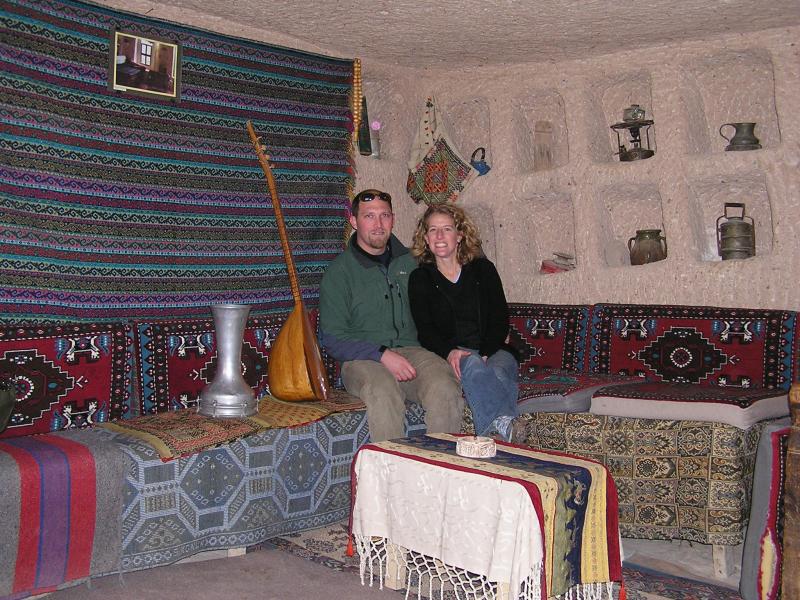
The most touristy part of our day was visiting a traditional family pottery factory and a carpet co-operative. Nevertheless, we had a great time learning about these two old traditional crafts from the Cappadocia area. M even "threw a pot" on the old fashioned foot-powered pottery wheel. She needs a little more practice to get work up the standards of the master potters from this family going back 400 years. The details that are painted on the plates, cups, vases, trays, etc. is quite amazing -
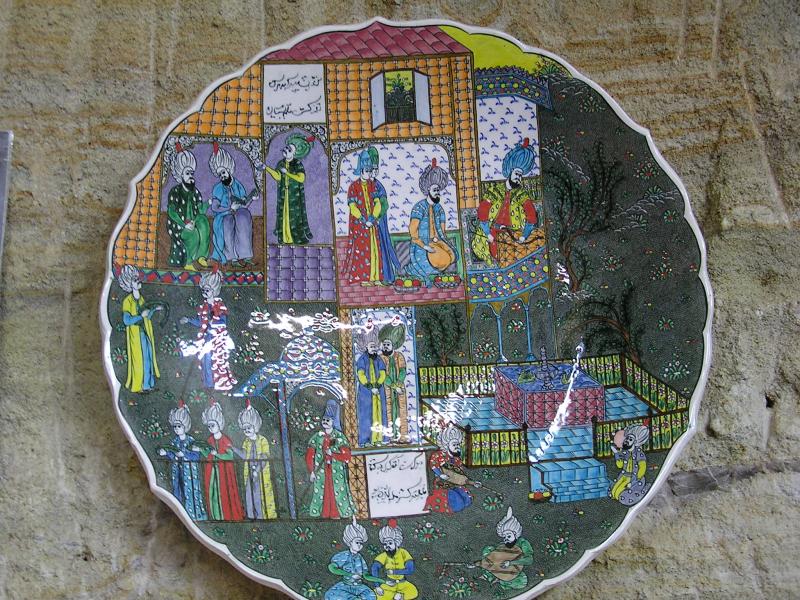
We then headed out to a very interesting place called Carpedocia. We learned how the traditional Turkish Carpets and Kilims are made. Also, how silk is collected from moths to use for the carpets. Of course we got the requisite tea and a carpet pitch. We didn't buy anything here, but of course we came away from Turkey with a carpet to put in non-existent home when we return.
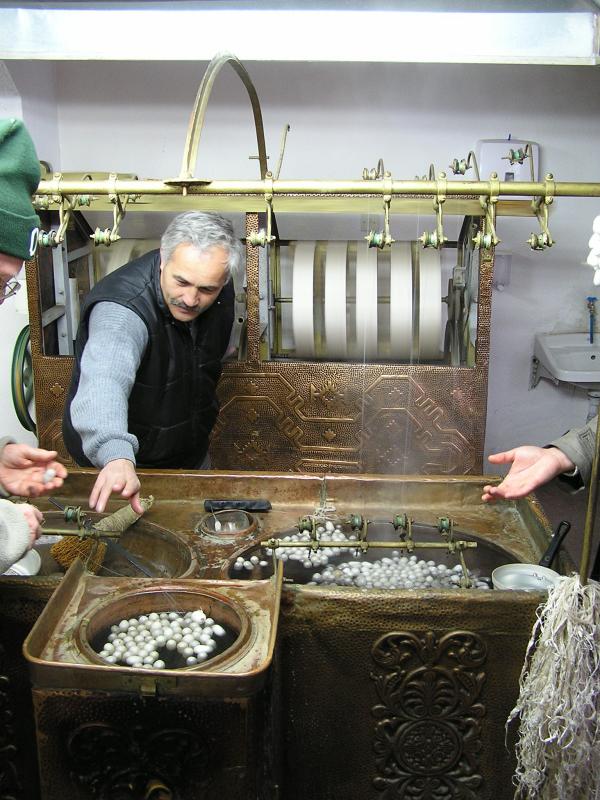
|
 |
 |
 |
 |
 |
 |
 |
Cappadocia Day #1
- |
 |
 |
 |

What a strange place Cappadocia is...It feels like we are on the moon! Most of the towns in this region have dwellings built right into rocks. The rocks are roughly conical in shape, rising into the air and topped by a mushroom cap formation, a natural phenomenon which was created by wind erosion aeons ago. The dwellings have holes cut into them for doors and windows, and the rock is soft enough for rooms to be dug into them.
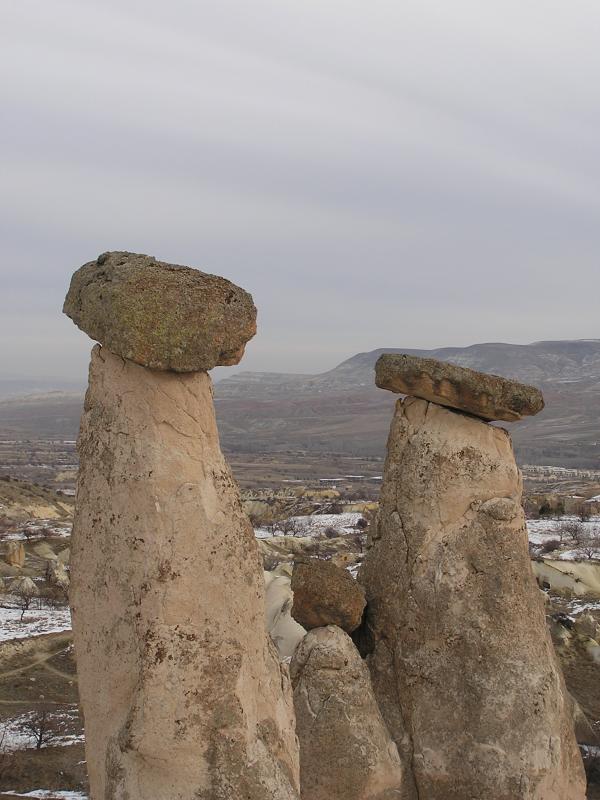
We signed up for a two day tour of the area. Our tour guide Ibrahim has a good sense of humor and tons of info that can't be found from reading a guide book. He told us about marriage traditions in Turkey. Apparently polygamy is prevalent with the Kurdish peoples in eastern Turkey though it is illegal. Also, 60-70% of all Turkish marriages are still arranged! At the first meeting for a couple who are courting, it is traditional for the woman to fix traditional Turkish coffee for her parents and suitor. If she is interested in the suitor, she makes the tea sweet. If not, she adds no sugar and sometimes even salt to indicate her lack of interest. Pretty harsh! Fifteen to twenty years ago, the parents had the final say in who the woman married, but now the woman has the final say.
First stop - the underground city of Derinkuyu
One of the main reasons for visiting turkey was to check out the subterranean towns of this region which extend up to eight levels into the earth, carved from the soft volcanic stone. Around the 11th century, the Christians in the area escaped to these rocks to avoid persecution. This huge underground city was capable of accommodating 10,000 inhabitants at a time of siege. The city was abandoned a long time ago and stayed hidden underground until 1968. There is another city in the area which is interconnected to Derinkuyu by a 9km underground tunnel. Scientists estimate that there are another 30 cities in the area yet to be discovered! This place is a kid's paradise, it's like a huge maze with hidden niches at every turn...
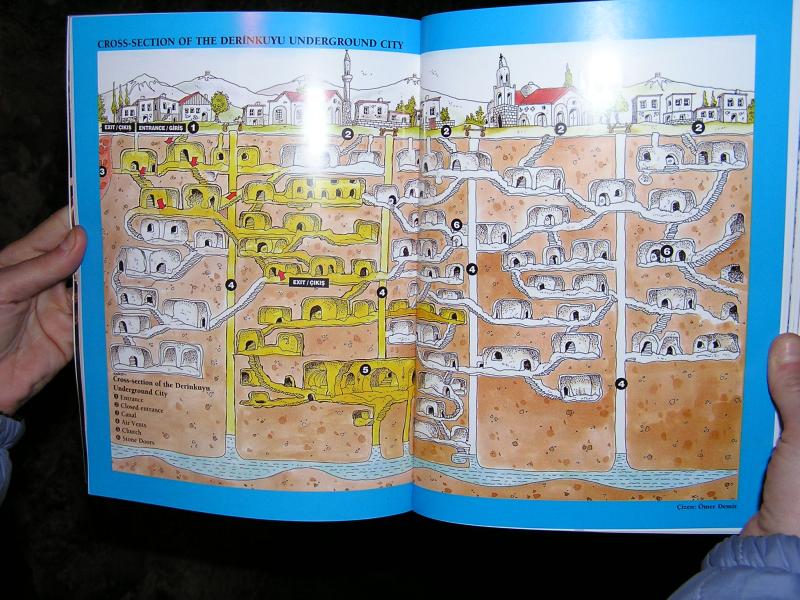
Rolling-stone doors prevented invaders from entering. Deep wells collected rainwater, and tall chimneys ventilation. Wine presses, oil storage, livestock pens, cooking-places and even elaborate churches were carved out of the soft volcanic rock so that the inhabitants could live for weeks or months underground until it was safe to emerge and return to their ground-level villages. Very impressive place, if not a little short for Dave.
Second stop - Ihlara Valley
We hiked down to the deep canyon which was formed by the water flowing down from the Melendiz mountains and the 10000 ft plusHasan Dagi throughout the millenniums. There are tall steep rock walls surrounding the 14kms long canyon on both sides. The valley reaches to the cave villages of Ihlara and Selimiye on both ends with more than a hundred churches from the 4th through 9th century carved into the rock walls of the valley. The entire hike would be just perfect on a warmer day!
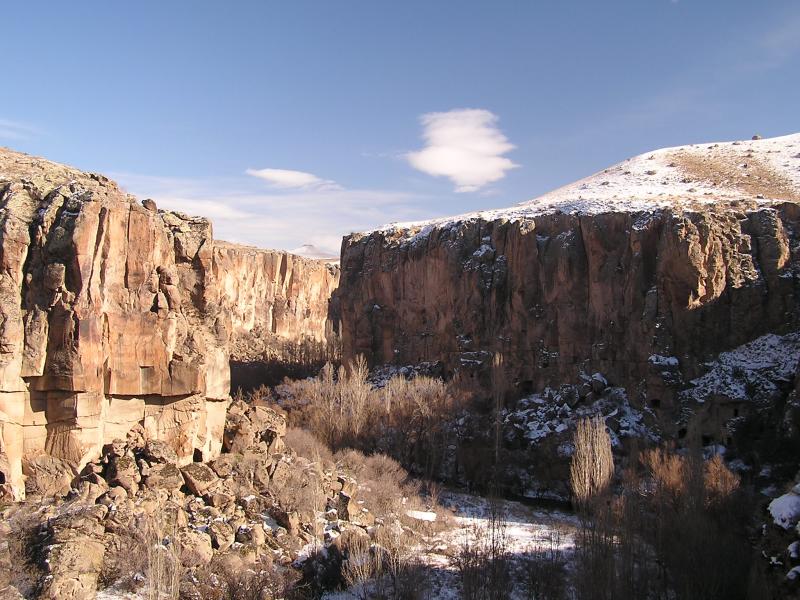
Third stop - Selimiye
We stopped next in a small town that had above-ground cave dwellings that were lived in as recently as 1920! Some scenes from one of the "Star Wars" movies was filmed here. We climbed up to the monastery, a large rock dwelling riddled with holes and a maze of cave rooms. Many people call these strange rock formations "Fairy Chimneys" as they look straight out of some strange fairy tale.
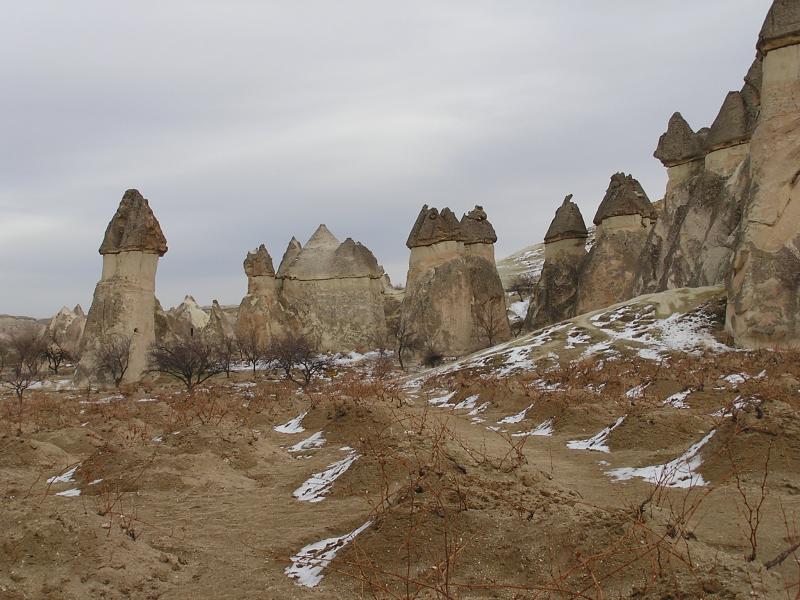
|
 |
 |
 |
 |
 |
 |
 |
Istanbul
- Sunday, December 21, 2003 |
 |
 |
 |

Having only been here in Istanbul for a short 24 hours, Turkey has left a great first impression. The food, ancient sights, and engaging people won us over quickly. Today we got a feel for the city and its beauty by riding a bus and tram around for a few hours.
The only official siteseeing accomplished today was a visit to the underground Basilica Cistern. This underground water storage system was built during the 6th Century linked by an aqueduct system to a water source 20km North of the city. It held up to 9800 sq. meters of water! It was damp and a bit spooky down there...Huge goldfish and carp were swimming around the 1ft deep water. Two of the 336 marble columns had the face of Medusa etched on their bases - one sideways, the other upside-down. Archaeologists have NO idea why!
The food is much different than Italy! We have been drinking Turkish coffee and apple tea all day..mmmm... STRONG. The food is an interesting mix of the Orient, Mediterranean, and Middle East. For lunch we had Pide, "Turkish Pizza." Pide is a long thin banana shaped bread, covered with the topping of your choice, and placed into a large, solid oven for about 10 minutes. The resulting pide is sliced up and served piping hot. We opted for the lightly spiced mince lamb and tomato topping but could have chosen from egg with a little cheese, sausage, or minced beef with onions...It was SO good.

Dinner was rather interesting. A man eating a bowl of soup struck up a conversation with us and invited us over to share his small bowl of soup. We changed tables glad to chat with a friendly Turk. From reading our guidebook, we recalled the Turkish rituals for sharing food: To turn down a request, you put your hand across your chest and politely refuse two times. If the gesture is genuine, accept on their 3rd offer or firmly refuse in the same manner. So, we did not offend the man, bought him a beer, and awaited our food.
After learning about his family, career, and military service in the 70s for a half hour, he started asking us pointed questions about American politics. We get into these types of interesting conversations with locals regularly and the majority of folks are genuinely interested in our perspective. This guy was more interested in talking about Americans' excessive living (he has a point!), reasons for invading Iraq (oil), and restrictive Visa policies. While the man had some good points, the conversation quickly became one sided as he told us to 'eat our food' anytime we tried to converse with him. It was starting to get weird. So, we are eating our dinner quietly at this point when the man suddenly screamed. It scared the hell out of us! We were very polite and enjoyed chatting with him for quite some time before his behavior started going south. We had NO IDEA what had set him off.
A man from another table immediately came over, said something in Turkish to our tablemate which resulted in his quick exit from the building. The owner of the restaurant, Azziza, came over and explained everything. It turns out that our dinner companion was a bit mentally unbalanced but not dangerous. He worked as a tailor in the neighborhood for many years before his mental health took a turn for the worse. Many restaurants in the area give him free meals occasionally. Apparently this has happened a few times before, but the restaurant owners still help this troubled man out. His outburst gave us quite a start, we are glad to have chatted with both he and the locals we met after his outburst.
Are we being stalked? We saw our buddy again at lunch the next day, not sure if he saw us? He did give a yell for the whole restaurant before being asked to leave! Poor guy...
We are off to the strange land of Cappadocia this evening on an overnight bus (yuk!) and hope to fill in the last month of back issues from Italy and Israel before leaving Turkey at the end of the month!
|
 |
 |
 |
 |
 |
 |
 |
Jerusalem
- Thursday, December 18, 2003 |
 |
 |
 |

The first day we arrived at sunset and met up for dinner with a friend of M's from her year in Israel back in 1988 as well as many years at summer camp. It was great to catch up with Caryn who now lives and works in Jerusalem full-time.
Our plans for the day centered on checking out the Old City which contains Jerusalem's most important historical and religious sites. Old City excavations have uncovered 20 distinct layers of civilization! Since tourism is down ~90% because of "the situation" here, we managed to snag our own personal tour guide. Unfortunately, rain, rain, hail, wind, and more rain greeted us when we awoke. We were lucky to make it through our tour without too much of a soaking since we were walking through alleyways and covered streets! Bente, a native Dane, has been guiding for 20 years and was full of useful information on our 3 hour tour.
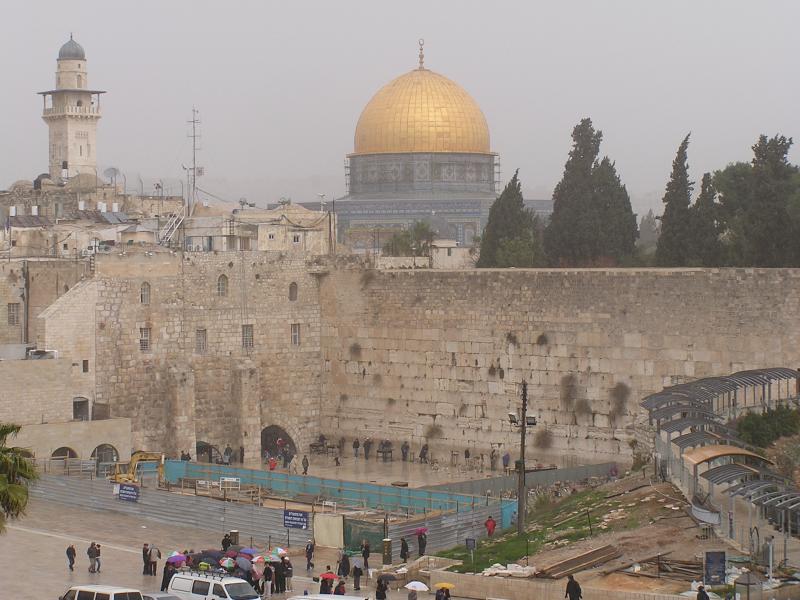
The Old City is roughly 1km square and is divided into the same four quadrants laid out by the Romans in 135 CE - Armenian, Christian, Muslim, and Jewish Quarters. The Old City houses important holy sites such as the Church of the Holy Sepulchre (Christianity), Temple Mount (Islam, Judaism, and 10 other ancient religions), as well as the Western Wall (Judaism). Why are these places so important?
The Temple Mount is a 35 acre area that is traditionally identified with the biblical Mount Moriah, where G-d asked Abraham to sacrifice his son Isaac. King Solomon built the First Temple here in the middle of the 10th Century BCE and Nebuchadnezzar destroyed it in 587 BCE, when the Jews were led into captivity. The Second Temple was built in 516 BCE, after the Jews' return from exile. Religious scholars believe that the Holy of Holies, the most sacred and important spot on the Temple, where only the High Priest was allowed to enter once a year, was closest to what is now the Western Wall, making this wall the holiest approachable site in Judaism.
Two mosques sit on the Temple Mount - al-Aqsa and Dome of the Rock. Both are BEAUTIFUL and contain intricate mosaics and metallic domes. As the third holiest sites behind Mecca and Medina, the Dome of the Rock is considered the place where Muhammad journeyed to on a winged horse and then ascended to the heaven where he met G-d before awaking back in Mecca. The Dome of the Rock surrounds what Muslims believe to have been Abraham's makeshift altar where he almost sacrificed Ishmael, his son by Sarah's maid Hagar. (Not Isaac as Jews and Christians believe)
For Christians, the Church of the Holy Sepulchre is the site traditionally believed to be the place of Jesus' crucifixion, burial, and resurrection. The Via Dolorosa (Path of Sorrow) is the route that the cross-bearing Jesus followed from the site of his condemnation to the site of his crucifixion and grave.
We started our tour in the Armenian Quarter which is the smallest with only 2K people and checked out their most holy site - St. James Cathedral. The Armenians still write and speak their own language, which is similar to Turkish.
The Muslim Quarter is the largest with 20K people; and the Jewish and Christian Quarters are split fairly evenly each with ~5K people. We next walked through the Jewish Quarter and noticed a big difference from the Armenian. The Jewish Quarter is all new and quite touristy by comparison to the other quarters. It was destroyed during Jordanian occupation from 1948-1967 and was slowly rebuilt in the ensuing years due to the extensive archeological projects which continue today. The Cardo was the original shouq and main thoroughfare during Roman and Byzantine times and has been partially restored to be lined with modern gift shops. The area surrounding the Western Wall was under construction, but we did manage to get a closer look at the M/F segregated site. The wall is strewn with pious worshipers and tiny paper notes fill the cracks in the wall, which the authors hope will be read by G-d.
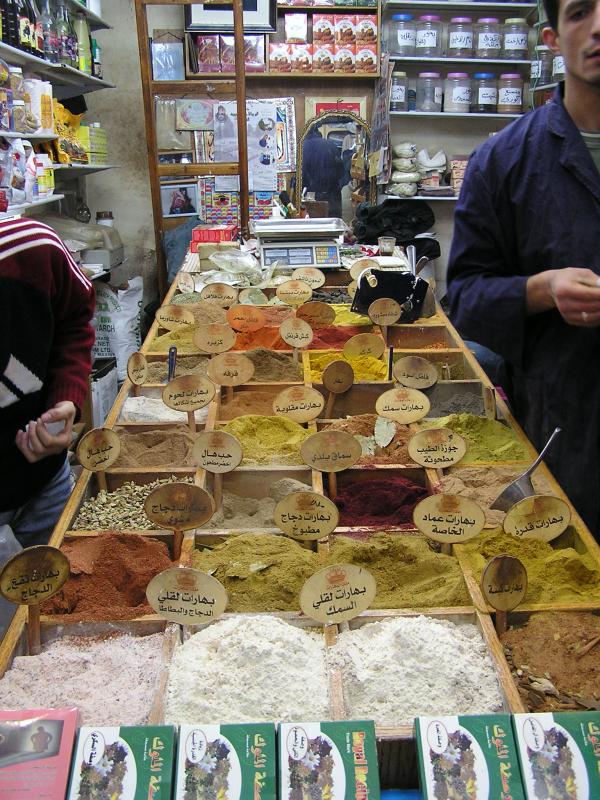
The Muslim Quarter is the largest, has the biggest shouq, and is the edgiest/scruffiest of the quarters. We walked through all the markets and were surprised not to see more tourists, only to find out that the Muslim Quarter isn't high on the list of tour paths. We loved the atmosphere, despite the high presence of Israeli police. We sampled an amazing drink called Sahlab made of orchids, cinnamon, coconut, and other special things. It was the consistency of creamed wheat- white in color, somewhat thick, but you can drink it. FANTASTIC! We enjoyed a respite from the rain/wind and chatted with the shop owner while drinking our Sahlab. His shop was formerly full of souvenirs. Because of the bad press Israel is getting and "the situation", he's had to change jobs. So many shops in this quarter were closed. We weren't able to visit the Temple Mount because it is only open at certain times, but we did sneak a pic.
The Christian Quarter is dominated by the Church of the Holy Sepulchre. The church is divided among the Franciscan, Greek Orthodox, Armenian Orthodox, Coptic, Syrian, and Ethiopian churches. The church is somewhat decrepit since the factions have a hard time agreeing on things. Each faction has its own chapel, some ornate, others rather simple. Jesus' tomb is a large marble structure flanked by huge candles and guarded by priests. Throughout our brief visit, we watched many priests from different denominations walking on a route from chapel to chapel swinging an incense burning lantern, stopping at each shrine.
After our tour ended, we wandered back to the shouq (market) in the Muslim Quarter to buy some pistachios and sunflower seeds and look for Hanukkah presents for M's nieces and nephew. We are spending the 1st night of Hanukkah back in Ramat Hasharon with The Bakers. This little adventure into the shouq made us realize how very little we know about kids!! What do you buy them?????? No clue. Left empty handed. Toys 'R Us seems like it would be easier b/c all the games have kids' age groups....right?
We left the Old City at ~3:30pm starved. The sky was gray; the rain blowing sideways, our umbrella was inside out most of the time. Being optimistic budget travelers, we decided to keep walking and not take a cab until we found the restaurant M's friend Caryn had recommended the previous night. Not so smart. The hail surprised us, and we took a beating as sunset came and went. It was worth the trek. We arrived at the restaurant dripping and ready to eat anything they put in front of us. While M can read Hebrew and understands many words, she is out of practice. This makes eating at restaurants somewhat challenging. Most folks know a bit of English but don't translate the whole menu for us. So we end up eating whatever the waitress recommends - Shishlik (kebabs), Shwarma (slices cut from pressed mutton roasted on a vertical spit), Humus, and Salads (cucumber & tomato mostly). The food is always VERY fresh, well seasoned, and YUMMY! This place is a vegetarian's paradise (Pam & Maria!!).
After our fabulous meal, we walked back to our hostel in the rain b/c we couldn't even find a cab and the dizzying array of bus routes left us too confused to try. After hanging our clothes out to dry, we headed out to a cafe overlooking the Old City to start preparing for our journey to Turkey on Saturday. We hope the weather is better tomorrow, as Jerusalem is a great city to tour by foot.
We ended our travels in Israel with The Baker family (M's cousin) on the first night of Hanukkah. After a big dinner, the kids lit the candles for the first night of Hanukkah, and we scarfed some donuts. It was great to end our trip with family. The kids were too cute!!

Oh yeah, they found Dave's bag after 10 days. Everything was wet, so our suspicions that it was lost in a snowbank might have been correct.......
|
 |
 |
 |
 |
 |
 |
 |
Northern Israel
- Sunday, December 14, 2003 |
 |
 |
 |

Haifa - We realized just how small Israel is when we drove from the Dead Sea to Haifa in a mere 2.5 hours! The funny thing was that it took us 45 minutes to get from Tel Aviv to Haifa and another 45 minutes to find our hotel through the windy, messy streets of Haifa... The next day we hung out with Seth Katz, a family friend of M's. She babysat him when he was a baby, and now he's in college. WOW, that made us feel very old!!
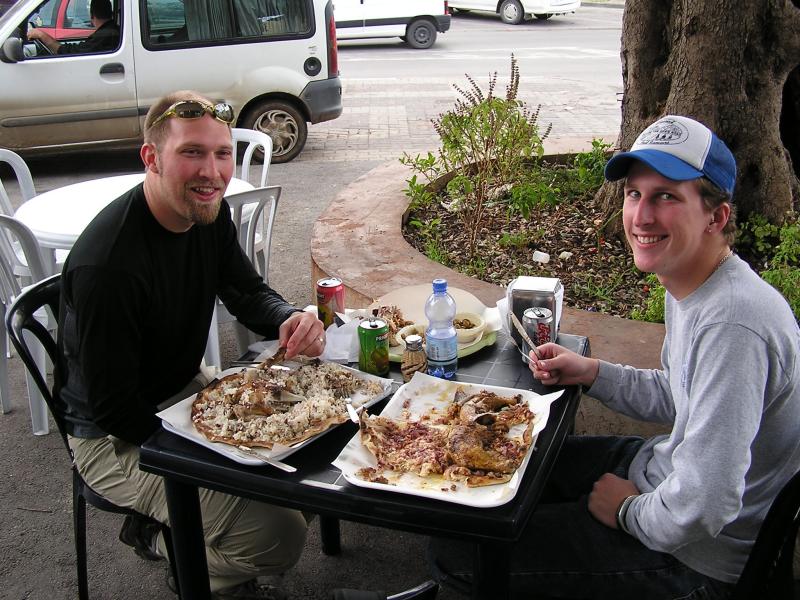
Haifa is Israel's 3rd largest city and is a very busy port. We spent some time hiking on the hills around Mt. Carmel and catching up with Seth. Lunch was from a nearby Druze Village named Isfiyah and was hands down the best food we had in Israel. It was great to spend time with Seth seeing the city..
Kibbutz Nes Amim - Cousins Patty and David hooked us up with their friend who manages the only Christian Kibbutz in Israel. So we got a screamin' deal on the bed and breakfast and were situated in a great spot to see the rest of northern Israel. We hired a tour guide to take us around the Golan Heights, as there is so much history and politics to learn about in this much disputed area. The Golan in Israel's northeast is borderd by Syria to the east and Lebanon to the north, only 25 miles from Damascus. The Golan was invaded at Israel's inception as a state in 1948 by Syria, again in 1967, as well as 1973. The problems in this area are so complicated. It's no wonder it's still not figured out yet!
We visited the Jordan River, Peter's Primacy, Capernaum Church, Kuneitra lookout point, and the Hula Wetlands Preserve, and many other stops. Our guide, Joram, was an interesting and well-informed guide who gave us a great tour and indepth insights to the politics of the area. The problems are complicated but are essentially centered around Israel's proximity to Damascus, access to water, and Syria's claim to part of the land lost in the '67 War. It will be interesting to see what happens in the coming year. The area was hilly, home to thriving vineyards, and has been relatively for the past 30 years. The UN still has a border presence in this area. Our visit to the bunker overlooking Syria was a real shocker because of the tanks and soldiers everywhere. Minefields are everywhere around strategic positions, leftover from Syria's occupation. Don't worry parents, these areas are VERY clearly marked! Look at the distances between cities on the sign below....so close!
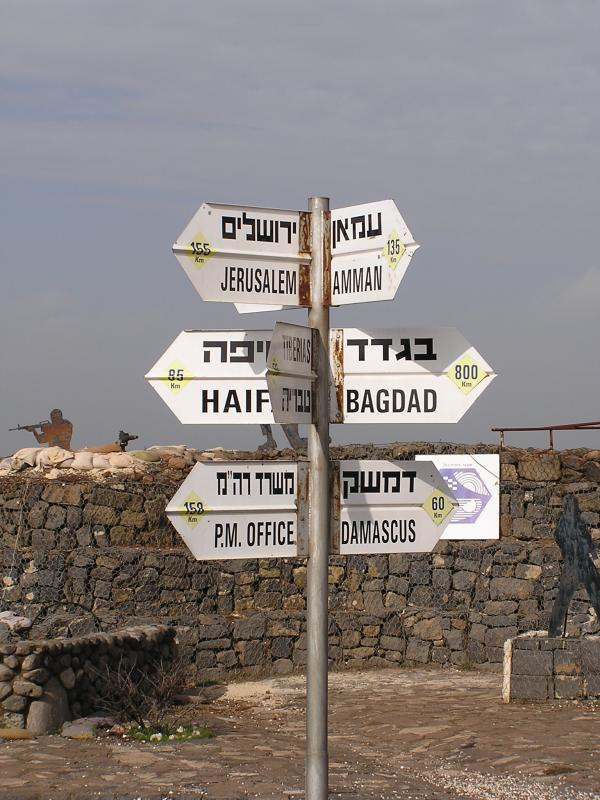
The Sea of Galilee is a sacred area for Christians because Jesus spent 3 years spreading his word in the area. We visited Capernaum Church from the 4th Century which is known as the site where Jesus fed 500 pilgrims with 2 fish and 5 bread loaves. The mosaics were beautiful.
Our day ended at the Hula Valley Nature Preserve where we were able to catch 30,000 cranes on a major stop during their journey south for the winter. At sunset, the cranes make their way from various fields in the preserve to a central pond. We felt like we were in a Hitchcock movie! It was too dark to get any really good pics, but we tried! The birds were so incredibly loud in their calls of directions to each other -where to land, turn right here, be careful over there, etc.. When our flash went off, no birds landed in the area for a good 10 minutes. Now that's communication!
Our next day was touristy as well, minus the fabulous guide. We headed to the northwest border with Lebanon to the caves of Rosh Hanikra and took a cable car ride down to the grotto for some exploring. Quick, fun, and beautiful. We drove on along the hilly border region to get a good look at Lebanon. Much of the area is off limits, but we did manage a drive through a couple of border villages complete with many bunkers of course.. We found a nice park to hike in to get our legs moving and found a really cool cave suspended in a cliffside.
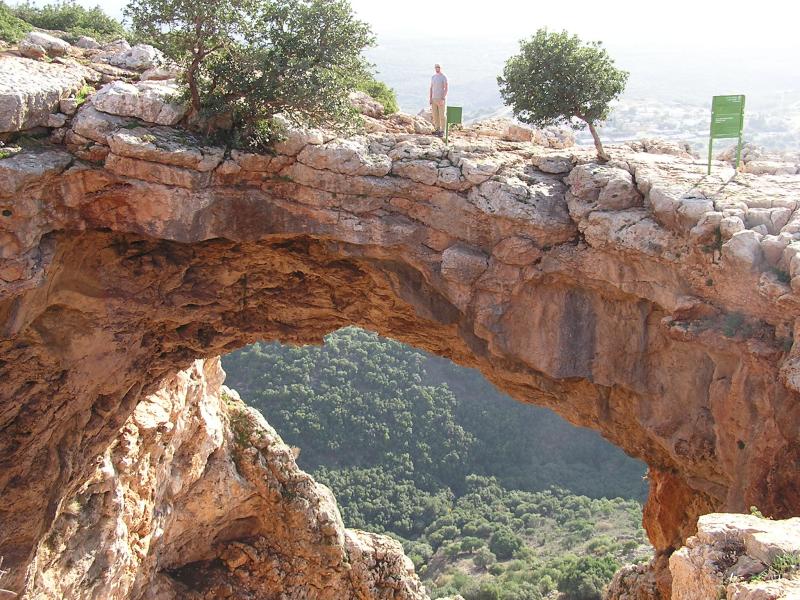
On our way back to Nes Amim Kibbutz, we visited the ancient Hasmonean town of Akko conquered pretty much by everyone because of its importance as a strategic port. We walked around in the old, walled city and took a tour of the underground Crusader ruins.
|
 |
 |
 |
 |
 |
 |
 |
Dead Sea Area
- Wednesday, December 10, 2003 |
 |
 |
 |

On arrival into Tel Aviv, at the rude hour of 5:30 AM, we began our travels through the Holyland. We took a cab ride to M's cousin Patty and her husband David's house, said hello and went to sleep immediately. After catching up on some much needed rest we hung out with them and their 3 kids (Ben, Noa, and Eshlee) and 3 dogs (Mocha, Jesse, and Tessa the 12 week old puppy).
Our two days in Ramat Hasharon with the family were relaxing, especially after the previous crazy week of visiting b-schools and interviewing. It was great to catch up! We also did some shopping because Dave's backpack was still missing after our flight to London. We think that it was stuck in a snow bank at JFK. The airlines provided us with some money to pick up some toiletries and a few essential clothing items.
M had spent a year here during 1988-89 in a youth program to learn more about Israel, Hebrew and life in the country. She had many good ideas before we arrived, but Patty & David really helped fill in the gaps with some great insight. Armed with a rental car and our completed itinerary, we set off for the Dead Sea. Our plan was to visit Masada, float and play in mud at the Dead Sea, and do some hiking in the Ein Gedi nature reserve.
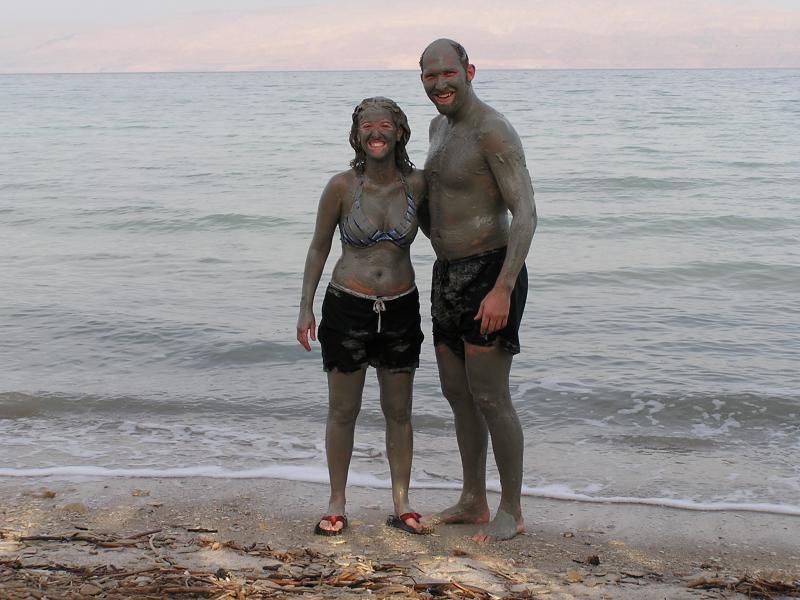
The weather was sunny, the hiking fantastic, and playing in the mud and floating the Dead Sea very surreal. Our visit to Masada was chock-full of history, and we were rewarded with a great view of the Dead Sea basin. After the 35 minute hike straight up the snake path, we toured the ruins for two hours. It's amazing how intact the ruins, pools, cisterns, and mosaics remain. Masada was Herod's royal citadel and later the last outpost of Zealots during the Jewish Revolt in 70 CE. The citadel was a site of the most dramatic and symbolic act in Jewish history, where rebels chose mass suicide rather than submit to Roman capture. Israeli soldiers are sworn in at this historic site.
The hiking in the Ein Gedi Reserve was also a great way to see the area and visit some beautiful waterfalls and natural springs that cascade out of the wadis (valleys). We also saw many Ibex which are small deer-like animals with really tall horns. In addition, all over the rock and root formations we saw small Marmot type creatures which would screech a warning to each other when we showed up in their territory.
Next, we headed down to the shores of the Dead Sea, which is the lowest point on earth 1,320 ft. below sea level and the saltiest and most mineral-laden body of water in the world. It is rather odd to float like a cork in what is essentially a big lake. Everything including rocks and driftwood along the shoreline was coated with dried salt. We scooped up some mineral-rich mud from the beach and slathered it all over ourselves. Our skin was baby-soft after the rinse off! We also soaked in the thermo-mineral springs, renowned for their healing powers, along with throngs of retirees.
|
 |
 |
 |
 |
 |
 |
 |
London
- Sunday, December 07, 2003 |
 |
 |
 |

After the whirlwind b-school tour, we headed out from North Carolina to JFK and finally London. Our timing was brilliant, as we were traveling during the 1st big snowstorm to hit east coast this winter. Both of our flights were delayed but not cancelled. We managed to fly out 4 hours late during the snowstorm. You’d think that would have given the baggage handlers enough time to put on the plane! Nope, both of ours turned up missing, so our time in London was bit chilly without our jackets. Our friends Will and Arabella whom we met while touring Guatemala, offered to pick us up from the airport, a bed to sleep in, and a tour of London.
W & A’s friend was performing in a small production in a local pub. Over a couple of pints, we chatted with some of their fun friends and enjoyed the play followed by some yummy Asian food. Mmmm…We spent most of the next day walking around downtown seeing all the sights with our fabulous tour guides D managed to get in a proper fish n’ chips lunch as well.
We are so happy to have been able to make a quick stopover in London to hang out with our friends!! These newlyweds are very well traveled and fun to hang around with. We hope to cross paths with them in the future.. maybe they’ll come visit us in the states.. hint hint!
|
 |
 |
 |
 |
 |
 |
 |
Suprise Thanksgiving!
- Friday, December 05, 2003 |
 |
 |
 |

We used miles to come home for a suprise Thanksgiving and also for D to visit and interview at b-schools. I think we suprised Dave's parents pretty good (Thanks Jen for keeping the secret)! After a busy weekend of hanging out with family in Seattle, eating leftovers, and getting to know our new niece Brynn & nephew Froggy it was work time.
Dave spent the week visiting 5 b-school campuses - U of Washington-Seattle, Colorado - Boulder, U of Minnesota- Minneapolis, U of Texas-Austin, and U of North Carolina - Chapel Hill
A very busy week!
It was quite a shocker for Dave as he had to shave and wear a suit for his interviews for the first time in a quite a while! All in all it was great to for D to check out the schools in person and get answers to specific questions, plus the bonus of catching up with our new neice and nephew.
Next is Israel, Turkey, Kenya, South Africa, and SE Asia.... Can't wait!
|
 |
 |
 |
 |
 |
|
|











